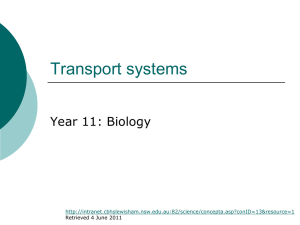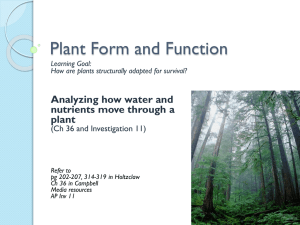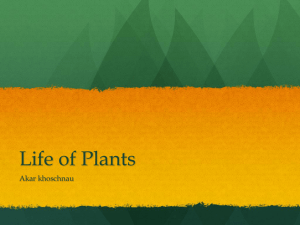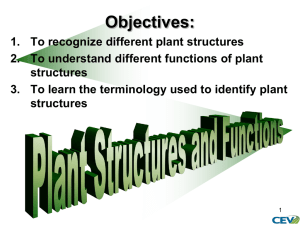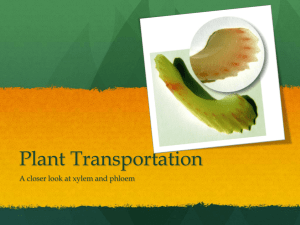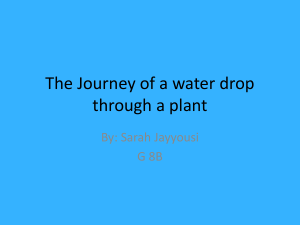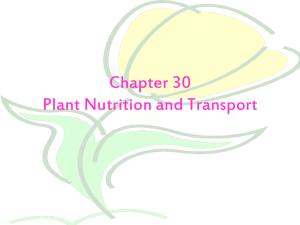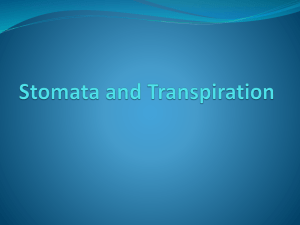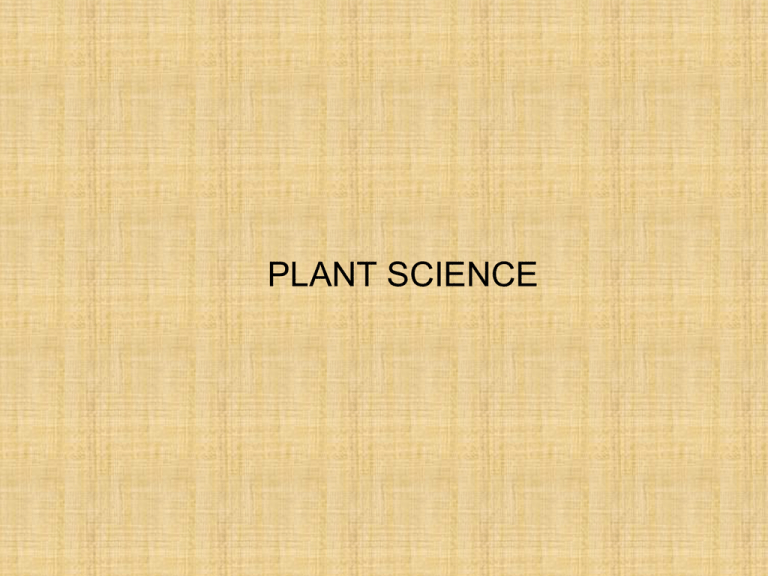
PLANT SCIENCE
Plant Classification
Examples 4 common plant divisions
-Bryophyta: mosses and liverworts
-Filicinophyta: ferns
-Coniferophyta: coniferous plants
-Angiospermatophyta: flowering plants
A. Bryophytes=mosses, liverworts,
hornworts
1. have no true roots, leaves or stems
2. have structures called rhizoids
(rhizoids are root like structures that
look like long hairs)
rhizoids
3. mosses have simple leaves and stems
4. liverworts consist of a flattened thallus
5. a thallus is a plant body not divided into true
roots, stems and leaves
6. bryophytes can grow up to 0.5 m
7. they do not produce flowers
8. bryophyte reproduction
-can be sexual or asexual
-often involves alteration of generations
-spores are developed in capsules that
are found at the end of stalks
9. bryophytes are often homosporous (the
gametophytes contain male and female sex
organs)
10.most common in damp habitats
B. Filicinophytes (ferns)
1. have, roots, leaves and short nonwoody stems
2. leaves are often curled up in buds and
are often pinnate
3. pinnate=leaves divided into pairs
4. ferns are vascular plants
-they have transport tissue called
vascular bundles (xylem and phloem)
5. can grow up to 15m
6. filicinophyte reproduction-spores are produced by sporangia,
usually found on the underside of the leaves
7. ferns can be heterosporous or homosporous
8. ferns do not produce flowers
C. Coniferophytes (conifers)
1. conifers are shrubs of trees with roots,
leaves and woody stems
2. leaves are often narrow with thick, waxy
cuticles
3. they are vascular plants
4. can grow up to 100m
5. reproduction-seeds are produced
-they develop in the ovules on the surface
of the scales of the female cones
-male cones produce pollen
6. coniferophyta are heterosporous
7. they do not produce flowers
Immature female cone
Mature female cone
Male cone
D. Angiospermatophyta-flowering plants
1. usually have true roots, leaves and stems
2. stems that develop into shrubs and trees
are woody
3. can grow up to 100m
4. reproduction
-seeds are produced
-they develop in the ovary
-ovaries are part of the flowers
-fruits develop from ovaries to disperse
the seeds
5. angiospermatophytes are heterosporous
Xerophyte adaptations
A. Xerophytes are plants adapted to dry
environments
--their adaptations allow them to obtain
the maximum amount of water from
their environment
B. Xerophyte=‘dry plants’
Xerophytes (cont)
C. The adaptations
1. reduced leaves (reduced surface area)
2. thick waxy cuticle
-reduces water loss
3. reduced number of stomata
-reduces water loss, gas exchange and
photosynthesis
4. Water storage tissue
-helps in long dry periods
Xerophyte adaptations (cont)
5. Stomata in pits and/or surrounded by hair
-reduces air flow past pore
-water that has diffused out will stay near
-this reduces the concentration gradient
and reduces the diffusion of water out of
the plant
Xerophyte adaptations
(continued)
6. Vertical stems
-allow absorption of
light early and late in
the day (not at midday
when light is most
intense)
-reduces
transpiration
Xerophyte adaptations (cont.)
7. Wide-spreading shallow root network
-allow immediate absorption of
extensive amounts of water
immediately after rain
8. CAM physiology
-stomata open at night and stay closed
during the day
Hydrophyte Adaptations
A. Hydrophyte= ‘water plant’
B. The adaptations
1. Air spaces
-allow the plant to float on top of
the water to absorb the most
sunlight
2. Stomata found in upper epidermis
(not in lower epidermis)
-open to air
Hydrophyte adaptations (continued)
3. Small amount of xylem in stems and
leaves
-xylem conducts water
4. Surrounded by water
-roots serve mainly as anchorage (not
water absorption
Plant Leaf Structure and Function
A. Leaf function=to produce food via
photosynthesis (C3, C4, CAM)
B. Leaves are adapted to their environments
(C3, C4, CAM)
C. Photosynthesis depends on gas exchange
over a moist surface
Plant Leaf Structure and Function
D. Cross section of a leaf
Upper epidermis
Cuticle
Palisade mesophyll
Xylem
Phloem
Spongy mesophyll
Lower epidermis
Guard cell
Stoma
Plant Leaf Structure and Function
E. Leaf anatomy
1. Upper epidermis-layer of cells covered by
a thick waxy cuticle
-prevents water loss from the upper
surface
2. Palisade mesophyll-densely packed
cylindrical cells
-contain many chloroplasts
-main photosynthetic tissue
-positioned near top of leaf for maximum
light absorption
Plant Leaf Structure and Function
E. Leaf anatomy
3. Xylem-vascular tissue responsible for water
transport
-replaces water lost during transpiration
4. Phloem-vascular tissue that transports minerals
-transports photosynthetic products out of leaves
5. Spongy mesophyll-cells that provide a means for
gas exchange
-have fewer chloroplasts than the palisade
mesophyll
-found near stomata and lower epidermis
Plant Leaf Structure and Function
E. Leaf anatomy
6. Stoma (stomata =pl.)
-pore that allows carbon dioxide to diffuse
in and oxygen to diffuse out
-also responsible for water loss
7. Guard cells-cells that open and close the
stomata
-control transpiration
Root Anatomy
(dicot)
Special layer with root
Hairs (protoderm)
Epidermis
Xylem
Root hairs
Phloem
Pericycle
Cortex of
parenchyma cells
Endodermis
Stem anatomy
(dicot)
Cuticle (outside layer)
Epidermis
Xylem
Pith of
parenchyma
cells
Cortex of
Parenchyma
cells
Phloem
Cambium
13.2 Transport in Angiosperms
Roots
A. Plants take in water and minerals through
their roots
B. Roots have large surface area to allow for
adequate uptake of water and minerals
-they are branched and they have root hairs
C. Function of the cortex=to facilitate water
uptake
D. Roots also act as anchorage to ground
Roots and active transport
A. Mineral concentrations are often higher in
the root than in the soil
B. This suggests active transport (going
against the concentration gradient)
C. Cortex cells can absorb ions that are
dissolved in the water that is drawn by
capillary action through the cortex cell walls
Water Uptake By Roots
A. Roots take in water via osmosis
-Water in the soil contains a lower
concentration of solutes than the
cytoplasm of root cells
-This causes water to diffuse in to the
roots
Water Uptake by Roots
Root cell
Soil
High solute
Low solute
H2O
H2O
**Water diffuses (osmosis) to an area of high solute concentration to
reach equilibrium between the roots and the soil
**Minerals are taken in via active transport because the roots have
higher solute concentration than the soil
Water Uptake By Roots (continued)
B. Most absorbed water is eventually drawn
to the rest of the plant because of
transpiration
-as water leaves the leaves it must be
replaced
C. To get water from the root hairs to the
xylem, there are three possible methods
-apoplast, symplast or vacuolar
pathways
Water Uptake By Roots (continued)
D. Apoplast pathway
-water does not enter the root cells
-it travels by capillary action through the cell
walls of the cortex until it reaches the
endodermis
-cells of the endodermis have Casparian
strips around them that are impermeable to
water
-to pass through the endodermis the water
must follow the symplast pathway (the
apoplast pathway stops at the endodermis)
Water Uptake By Roots (continued)
E. Casparian Strips
-found in endodermis
-thought to be a protective measure
-prevent water from seeping between cells
-forces water to enter the endodermis
before passing to the vascular tissue
-forces water to go through cell walls (not
between them
Water flow with Casparian strips
Casparian strip
Cell wall
Cell
membrane
Water flow (cannot flow
between cells when Casparian
strips are present)
Vacuole
Water flow without Casparian strips
Cell wall
Cell
membrane
Water flow
Vacuole
Water Uptake By Roots (continued)
F. Symplast Pathway
-water enters the cytoplasm of the cells,
but not the vacuole
-water passes from cell to cell via the
plasmodesmata (connections of cytoplasm
between cells)
-the water eventually enters the xylem
Movement Through Roots
Water Uptake By Roots (continued)
G. Vacuolar Pathway
-water enters the cells and moves to the
vacuole
-when necessary the water will travel
through the cytoplasm and cell wall to the
vacuole of the next cell
Assignment: Make a chart to
compare apoplast, symplast
and vacuolar pathways
The Xylem
A. Function-to transport water and
dissolved minerals from the roots to
other parts of the plant
B. Mature xylem cells are dead
C. Made of two components
1. tracheids
2. xylem vessels
The Xylem (continued)
D. Tracheids
-narrow cells, arranged in columns
-overlap at tapered ends
-function as support
-overlapping ends have pits that allow
water to move rapidly between cells
-all plants have tracheids
-not as efficient as xylem vessels
The Xylem (continued)
E. Xylem vessels
-most water travels through vessels
-composed of columns of cells
-when the cells die the walls between
them disappear partly or completely
(leads to more efficient transport)
-diameter is wider than tracheid diameter
-side walls are reinforced with lignin (this
helps with structural support)
Tracheid
Xylem vessel
Water Transport Through Plant Tissue
A. Transpiration=loss of water vapor from
leaves and stems
B. Transpiration causes water flow from
roots, through stems and to the leaves
C. Transpiration stream = describes the
transpiration flow through the plant
D. The process begins with evaporation of
water from the leaves (through the spongy
mesophyll)
Water Transport Through Plant Tissue
(continued)
E. Evaporated water is replaced with more
water from the xylem
F. Capillary action allows the water to move
from the xylem to the spongy mesophyll
G. The capillary action creates transpiration
pull
-transpiration pull= low pressure or
suction within the xylem
H. Water molecules have strong cohesion
forces
Water Transport Through Plant Tissue
(continued)
I. As water moves out of the vessel, other
molecules will want to replace it
J. All water will move up a little (toward the
leaves), at the other end of the plant (the
roots) water will move from the soil to the
plant
Water Cohesion
A. Water molecules are attracted to each
other
B. These are intermolecular forces
C. This is created by hydrogen bonding
The whole point:
EVAPORATION CAUSES TRANSPIRATION
PULL. THIS PULLS WATER INTO THE
ROOTS AND TO THE REST OF THE
PLANT BECAUSE OF THE STRONG
COHESION OF WATER MOLECULES.
Phloem
A. Primary function= translocation
B. Translocation-movement of substances
from one part of a plant to another in the
phloem
C. Sugars, amino acids and other organic
compounds produced by photosynthesis are
transported away from the leaf
-materials sprayed on the plant can also
be transported from the leaves via the
phloem
Phloem
D. Found in all leaf veins
E. Materials can be transported in both directions
**Remember xylem only transports one way (up)
Ex: In summer trees transport sugars from
leaves to roots
-In spring transport sugar from roots
(where it is stored) to the new branches
Food storage in plants
A. Many perennial plants have food storage
for dormant seasons
B. The food is transported when necessary
by the phloem from the root to the rest of the
plant for new growth
C. Examples:
1. Carrots-carrots store food in
the cortex of their roots
-may be used to allow the
growth of stems and leaves
after winter
Food storage in plants
C. Examples (continued)
2. Seeds
-seeds need a certain amount of food to
allow them to grow a stem
and a few leaves
-this food usually lasts until
photosynthesis takes over
3. Tubers (potatoes)
-tubers are swollen
underground stems
that store food
Other plant modifications
A. Tendrils-used for climbing
-modified leaves or stems
-Example: grape vine or ivy
B. Bulb - any plant that stores its complete
life cycle in an underground storage
structure
-usually perennial flowers have this type
of structure
Classwork (in your notebook)
Explain the relationship between the distribution of
tissues in the leaf and the functions of these
tissue. [8]
Draw and annotate a diagram showing the structure
of a dicotyledonous animal-pollinated flower.
-Include: 1. sepal 2. petal 3. anther 4. filament
5. stigma 6. style 7. ovary
Draw and annotate a diagram showing the external
and internal structure of a named dicotyledonous
seed.
-Include: 1. testa 2. micropyle 3. embryo root 4.
embryo shoot 5. cotyledons
Plant support
A. No skeleton
B. Xylem vessels have some support tissue
that help keep the plant upright
-xylem alone is inefficient (think about
wilting plants)
C. Trees and shrubs have woody stems
D. Herbaceous (non-woody) plants use turgor
for support
Plant support
E. Turgor
-vacuoles take up water
-the cell swells up
-the cell wall is stretched to the limit
-the vacuole still has less water
potential than the cytoplasm and
continues to draw in water
-the force of the cell wall forces water
out at the same rate
More on guard cells
A. Plants maintain large surface areas to
capture sunlight
B. To avoid water loss their surfaces are
covered with waxy cuticle layers
-cuticle also is impermeable to gases
(oxygen and carbon dioxide)
C. Pores in the cuticle and lower epidermis
allow gas exchange within the spongy
mesophyll
More on guard cells
D. When the plant is at risk of drying out the
guard cells lose turgor and sag together, closing
the stomata
E. This reduces water loss and photosynthesis
F. Because photosynthesis is reduced guard cells
only close the stomata when the plant is at risk
G.Guard cells regulate transpiration by opening
and closing the stomata.
-A plant hormone called abscisic acid
causes the stomata to close. (This is helpful
during times of drought or stress.)
Anatomy of stomata and guard cells
Pea leaf stomata and guard cells
Four abiotic factors that affect the rate of
transpiration in typical mesophytes
Mesophytes-plants adapted to conditions of
average water supply (not xerophytes or
hydrophytes
A. Light
-plants generally open stomata in day to
allow carbon dioxide to diffuse in and
allow photosynthesis to occur
-this increases transpiration
Four abiotic factors that affect the rate of
transpiration in typical mesophytes
B. Temperature
-as temperature increases transpiration
also increases because high temperatures
increase the rate of diffusion and decrease
relative humidity
-the rate of transpiration doubles for every
10 degree C increase in temperature
Four abiotic factors that affect the rate of
transpiration in typical mesophytes
C. Humidity
-Decrease in humidity = increase in
transpiration
-Increase in humidity=decrease in
transpiration
**This is directly related to concentration
gradients
Air
Low humidity
Low moisture
H2O
Plant
Increase
transpiration
Air
High humidity
High moisture
Plant
Decrease
transpiration
Four abiotic factors that affect the rate of
transpiration in typical mesophytes
D. Wind
-High winds increase transpiration
-When the wind blows it moves moist air
away from the stomata
-When the air is still there is no current to
move the water saturated air away from the
stomata (moist air stays above the stomata
and reduces transpiration)
Questions to Consider
1. When a farmer sprays a chemical on to crop plants, how does
the chemical travel to the roots of the plants?
a. In the phloem, by active translocation
b. In the phloem, by transpiration pull
c. In the xylem, by active translocation
d. In the xylem, by transpiration pull
2. Roots take up minerals from the soil by:
a. osmosis
b. facilitated diffusion
c. active transport
d. diffusion
3. What causes movement of water through the xylem?
a. active transport in the root tissue c. active translocation
b. evaporation of water from the leaves
d. gravity
4. Describe how water is transported in a plant. [4]
Questions to consider (and turn in)
1. Draw a labeled diagram to show the
arrangement of tissues in a leaf.
2. Explain how roots absorb water and then
transport it to the xylem, noting any special
adaptations that help these processes to
occur.
Reproduction in flowering plants
Pollination, fertilization and seed dispersal
A. Pollination -the transfer of pollen grains from the
anther to the stigma
1.self pollination
-the plant pollinates itself
2. cross pollination
-one plant pollinates another
-the plant’s genes are spread
3. Male gametes must use an external force to
transfer the pollen (wind, animals)
Pollination, fertilization and seed dispersal
B. Fertilization
1. The fusion of male and female gametes to form a
zygote (happens inside the ovule)
2. Pollen develops from the anthers (male gamete)
3. Female gametes are found in the ovules in the
ovaries of the flowers
4. Ovules that become fertilized develop into seeds
5. Ovaries with fertilized ovules develop into fruits
**Pollination does not always lead to fertilization
Path of pollen to fertilization
Anatomy of a flower
Draw, Label and Annotate
Anatomy of a flower
Pollination, fertilization and seed dispersal
C. Seed dispersal
1. One of the primary functions of fruits is
seed dispersal
2. Seeds are often dispersed by animals or
insects
-Ex: The seeds pass through animal
intestines and are released
3. Seeds can be carried by wind
4. Fruits can explode and disperse the seeds
5. Seeds can be dispersed by moving water
This plant
grows near
water. The
fruit bursts,
the seeds fall
in the water
and the river
carries them
away.
Wind dispersal
Pond Iris
Exploding fruit
Carduus nutans
(nodding
plumeless thistle)
Impatiens capensis (orange spotted touch me not)
Dicotyledonous and monocotyledonous
seed structure
A. Dicots-have 2 seed leaves(two cotyledons)
1. Mature plants have broader and shorter
leaves with net-like veins
2. Examples: Oak trees
Buttercups
3. Dicotyledonous seed internal anatomy
Phaseolus multiflorus (a bean seed)
DICOT SEED ANATOMY
B. Monocots -have one seed leaf (one
cotyledon)
1. Mature plants tend to have long, narrow
leaves with parallel veins
2. Examples:
Grasses
Palm trees
A typical monocot seed
Required conditions for seed germination
A. Seeds are normally in a dormant condition
(they grow in the parent plant and become
dormant when they leave)
B. The dormancy must be broken for the seed
to germinate
C. Germination=the resuming of growth or
development from the seed
Required conditions for seed germination
D. Breaking the dormancy
-water must be available for hydration of tissues
inside the seed
-oxygen must be available for cellular respiration
-suitable temperatures (seeds stay dormant at
temperatures that are too low or too high because
enzyme activities are altered)
-ideal light conditions (to ensure photosynthesis will
be possible)
-wearing down of the testa (seed coat)
Metabolic events during germination
A. Absorption of water
-presence of water activate hydrolytic
enzymes
-the seed will become metabolically
activated
B. Gibberellins are produced
- Gibberellins are plant growth hormones
produced by the cotyledons
-Gibberellins stimulate the production of
amylase which breaks down stored
starches into maltose
Metabolic events during germination
D. Maltose is moved to the embryo and
eventually converted into glucose
E. Glucose is used in cellular respiration to
produce energy or it is used to make cellulose
for cell walls
F. Stored proteins and lipids are hydrolyzed
-The amino acids produced will be used to
make new proteins or used as enzymes
-The fatty acids and glycerol produced will be
used in the cell membrane as phospholipids
Metabolic events during germination
F. Continued
-The food reserves are stored as large
insoluble macromolecules in seed.
Not useful
Useful
G. When the leaves of the seedlings reach
sunlight photosynthesis will begin to supply the
necessary nutrients (seed energy stores are no
longer needed
Phaseolus multiflorus seedling (after about two weeks)
Work ahead
1. Explain how flowering is controlled in
plants.
2. What is a photoperiod?
3. Distinguish between long and short day
plants.
4. Explain the experiment dealing with red
and far red light and plant flowering.
Flowering in plants
A. Phytochrome-a photoreceptor that plants
use to detect light
B. Photoperiod-relative lengths of night and
day
C. Photoperiodism-physiological response to
photoperiods
D. Flowering in plants is related to A, B and C
Flowering in plants
A. Three types of plants (you should be able
to figure out which plants need
longer/shorter photoperiods)
-short-day (ex: poinsettas)
-long day (ex: spinach)
-day neutral (ex: tomatoes)
B. Each type of plant has a defined
photoperiod
EXPERIMENT
RESULTS
(a) “Short-day” plants
flowered only if a
period of
continuous
darkness was
longer than a critical
dark
period for that
particular
species (13 hours in
this
example). A period
of
darkness can be
ended by a
brief exposure to
light.
During the 1940s, researchers conducted experiments in which
periods of darkness were interrupted with brief exposure to light to
test how the light and dark portions of a photoperiod affected
flowering in “short-day” and “long-day” plants.
Critical dark period
Darkness
Flash of
light
Light
(b) “Long-day”
plants
flowered only
if a
period of
continuous
darkness was
shorter
than a critical
dark
period for that
particular
species (13
hours in this
example).
CONCLUSION The experiments indicated that flowering of each species was determined
by a critical period of darkness (“critical night length”) for that species, not by a
specific period of light. Therefore, “short-day” plants are more properly called
“long-night” plants, and “long-day” plants are really “short-night” plants.
Flowering in plants
A. There are two types of red light
-Pfr-far red absorbing
-Pr-red absorbing
B. Pfr promotes flowering in short-day plants
C. Pr promotes flowering in long-day plants
Action spectra and photoreversibility experiments
– Show that phytochrome is the pigment that receives red light,
which can interrupt the nighttime portion of the photoperiod
24
EXPERIMENT
A unique characteristic of
phytochrome is reversibility
in response to red and
far-red light. To test whether
phytochrome is the pigment
measuring interruption of
dark periods,researchers
observed how flashes of red
light and far-red light affected
flowering in “short-day” and
“long-day” plants.
20
R
FR
R
R
FR
R
FR
R
FR
R
16
12
RESULTS
8
4
0
Short-day (long-night) plant
CONCLUSION
Long-day (short-night) plant
A flash of red light shortened the dark period. A subsequent flash of far-red
light canceled the red light’s effect. If a red flash followed a far-red flash, the effect of the farred light was canceled. This reversibility indicated that it is phytochrome that measures the
interruption of dark periods.
Distinguishing between monocots
and dicots
Leaf venation
Monocots
Dicots
Parallel
Net-like
Adventitious roots
Tap roots w/ lateral
branching
Vascular tissue
distribution
Number of
cotyledons
Floral organs
Root types
Apical vs. Lateral Meristems in
Dicots
A. Apical meristems allow primary growth
-found in buds and tips of shoots
-allows plants to grow organs and develop
the shape of a plant
B. Lateral meristems are responsible for
secondary growth
-make the stem grow thicker and/or
develop new vascular bundles
-found in cambium
Auxin and plant growth
A. Auxin-a plant growth hormone
B. Best known auxin is IAA
C. Produced by apical buds and transported down
stem (towards the end)
D. Accumulates at shaded side of plant
E. Stimulates cell divisions and stretching
F. Activity is related to phototropism (growth
response in response to light)
G. Auxin allows positive photropism (the plants
grow towards the light
H. Read p. 152 of the green IB textbook.
Compare growth due to apical and lateral
meristems in dicotyledonous plants. [6]
Explain the role of auxin in phototropism as an
example of the control of plant growth. [6]
Distinguish between monocots and dicots.
Monocots
Leaf venation
Vascular tissue
distribution
Number of
cotyledons
Floral organs
Root types
Dicots
Review
1. Draw and label a flowering plant (from
memory).
2. Describe the metabolic events of germination
in a starchy seed.
3. Explain how abiotic factors affect the rate of
transpiration.

